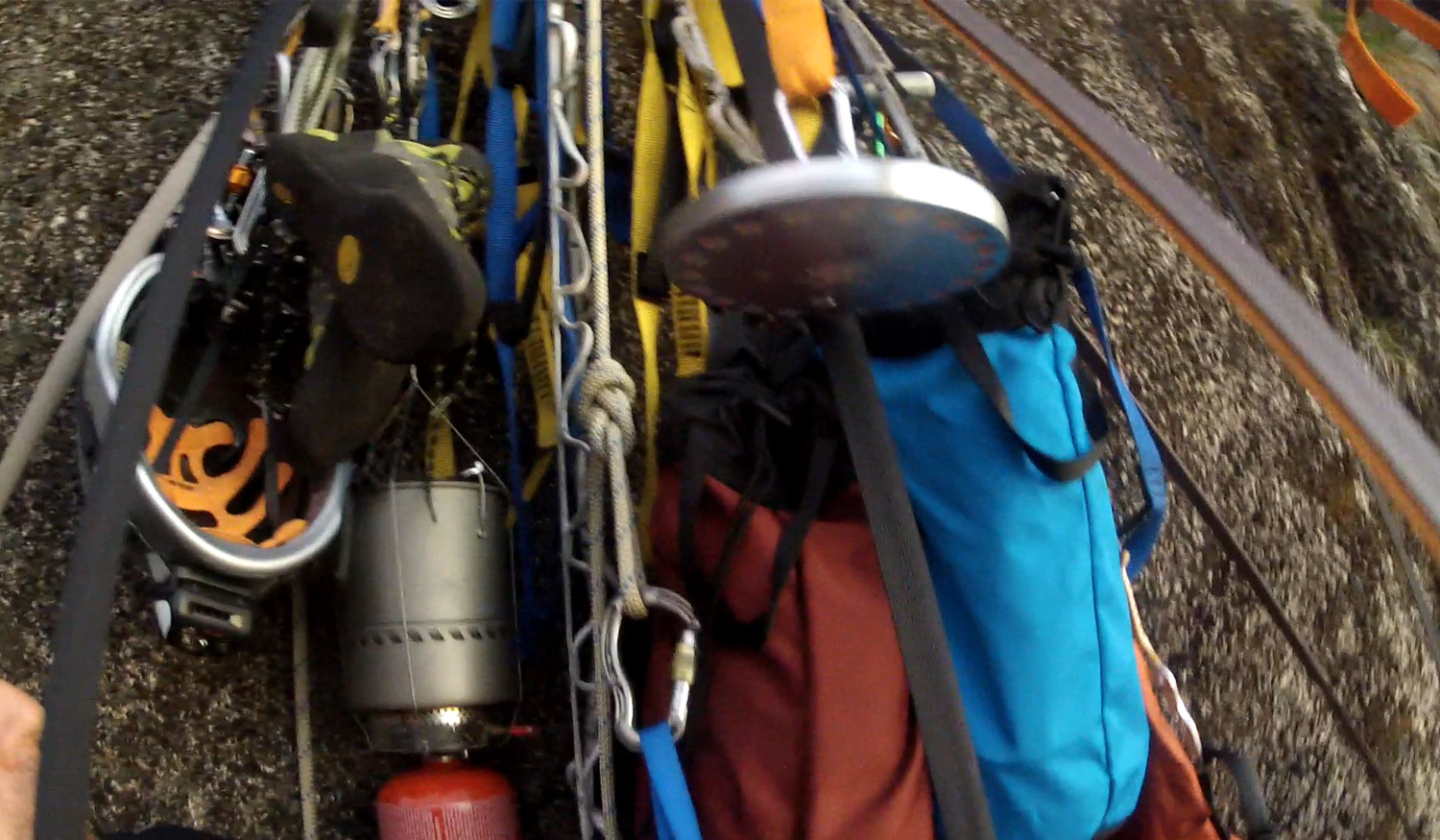Waking up at sunrise on portaledge. Mt Buffalo Gorge, Victoria, Australia.
Generally, people think the idea of sleeping on a portaledge is crazy. To many people, the concept of spending the night on a flimsy piece of nylon suspended on a sheer cliff face hundreds of metres above the ground is simply insane. Curiously, if and when people do come to accept the idea, the first question they usually ask is, ‘How do you go to the toilet?’
All gear tied in securely.
Sleeping on a portaledge is an extreme form of camping. In simple terms, the portaledge is a tent that has been designed to hang off cliffs. Living in it requires a high level of self-sufficiency. Everything you need has to be at hand’s reach as, obviously, ducking out to grab some supplies isn’t an easy option. And you need to have everything tied in and be constantly on guard. If given the chance, gravity will remove everything from your possession, permanently. And that includes your life!
People are often curious about how well you sleep on a portaledge, or whether you have a lot of weird dreams. As Freud once commented, ‘dreams are the royal road to the unconscious’. It’s commonly known that the anxieties and stresses of waking life can rear their ugly heads in the form of dreams during sleep. Sleeping on a portaledge takes this to an extreme level in the sense that the cause of the anxiety or stress (in this case, the threat of falling to one’s death) is still very much present during the sleep itself.
The psychology of fear
As with other human emotions, fear may be either innate or learned. It’s an unpleasant feeling, and it typically results in avoidance.
Bird's eye view of the 300m vertical drop from portaledge on North Wall of Mt Buffalo Gorge, Victoria, Australia. Image taken by drone.
It’s easy to understand that an instinctive avoidance of danger is an advantage from an evolutionary perspective. It doesn’t take Charles Darwin to point out that a lack of fear makes it less likely for a person to live long enough to reproduce. (Though admittedly extreme adventurers can sometimes show a reproductive advantage by attracting members of the opposite sex with their daring feats!)
However, situations can often elicit a fear response that is inappropriate. For example, a fear of heights may not take into account the fact that we’ve taken steps to ensure our safety, like by tying in to a secure rope. In these situations we might be totally safe in objective terms, so to some extent the fear inhibits us unnecessarily.
The conscious control of fear
At Unleashed-Unlimited, one of our major focuses is on the ability to achieve a goal by directing action with rational decision making, even under adverse conditions. In psychological parlance, this means employing executive control functions to overcome limitations that are imposed by instinctive or habitual reactions, such as fear.
In this sense, the fear of hanging off a cliff face is analogous to the many fears that we may face in the course of our everyday lives. This could be in situations like doing a public presentation, going for a job interview, getting out onto the sports field, or asking that special someone out on a date. Through exposure and with practice we can gain conscious control and overcome these fears, and rationally direct our actions towards our goals.
Loss of conscious control during sleep
Going back to sleeping on the portaledge, we might then ask, do we lose that conscious control of fear as we slip into our slumber?
Sleeping soundly hundreds of metres off the ground. Mt Buffalo, Victoria, Australia.
Obviously everyone’s reactions are different, but in my early experiences I found my transition into sleep was frequently interrupted by abrupt awakenings. I would wake up with a big jolt as my mind drifted off with imaginings of horrific plummets to the valley floor below. At times I was even seen to be sleeping ‘soundly’ with my hand clutching desperately the tethers that held me to the wall. This is despite that fact that I had felt quite comfortable in that same vertical environment whilst climbing during the day.
We could interpret this as showing that I’d merely suppressed my fears whilst awake, and these fears were surging back to haunt me in my dreams. A more positive view would be that the extreme environment was leading to accelerated processing and development in my brain, and this was represented by dreams that were so intense that they were waking me up. In support of this second view, I can say that with time I’ve become far more accustomed to the situation, and can now sleep quite happily.
Whatever the case may be, sleeping on a portaledge is certainly an experience that is out of the ordinary, and it provides some food for thought. Oh, and I still haven’t gotten around to answering the question of how you go to the toilet. Well, that’s a whole other story…
The Unleashed-Unlimited Beyond the Edge Experience includes one night for two people on a portaledge hanging at around 300m on the majestic North Wall of Mt Buffalo gorge and an optional 300m abseil. Contact us if you are interested in finding out more.




